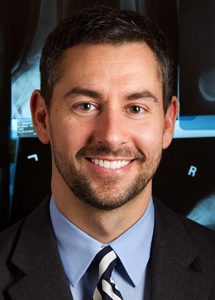OSS will be closed this Thursday, November 23rd, 2017 and Friday, November 24th, 2017.
Tune in to hear Dr. Mark Reed on KOMO Radio-Sunday, November 19th

Catch Dr. Reed’s on-air radio segment this Sunday, November 19th on KOMO News Radio 97.7 FM/1000 AM. He will be speaking about big toe arthritis and what can be done to treat this condition.
The program runs from 11:00am-12:00pm. His segment will air at 11:30am.
Magnetic Resonance Imaging (MRI) – Accredited Facility
Seattle Orthopedic Center has been awarded a three-year term of accreditation in magnetic resonance imaging (MRI) as the result of a recent review by the American College of Radiology (ACR).
The ACR gold seal of accreditation represents the highest level of image quality and patient safety. It is awarded only to facilities meeting ACR Practice Parameters and Technical Standards after a peer-review evaluation by board-certified physicians and medical physicists who are experts in the field. Image quality, personnel qualifications, adequacy of facility equipment, quality control procedures and quality assurance programs are assessed.

Orthopedic Surgeon vs Podiatrist
There is often confusion regarding the difference between orthopedic surgeons specializing in the foot and ankle and podiatrists. There is significant overlap between the two specialties in terms the types of issues they treat.
Commonalities between an Orthopedic Surgeon and Podiatrist
 Both orthopedic surgeons specializing in foot and ankle surgery as well as podiatrists treats a myriad of conditions effecting the foot and ankle include the following:
Both orthopedic surgeons specializing in foot and ankle surgery as well as podiatrists treats a myriad of conditions effecting the foot and ankle include the following:
- Injuries such as a fractures, sprains, and strains
- Congenital deformities
- Degenerative changes
- Nerve entrapments
The Difference
Ultimately there is a difference in the training providers from each specialty go through. Orthopedic surgeons complete a 4 year undergraduate degree, 4 years of medical school, 5 years of a general surgical residency, and typically an additional year in a orthopedic subspecialty, such as foot and ankle. They must then practice in the field of orthopedic surgery to become board certified. Podiatrists complete a 4 year undergraduate degree, 4 years of pediatric school, and 3 years of residency.
Here at Orthopedic Specialists of Seattle we have Dr. Mark Reed, a board-certified orthopedic surgeon specializing in conditions of the foot ankle. He is supported by an excellent team of physician assistants.
Broken Foot: Common Symptoms and Treatments

There are several medium and small bones that make up the three sections of the foot. The forefoot includes the slender bones that make up the 5 toes (phalanges) and the anterior portion of the arch of the foot (metatarsals).
The mid-foot is made up of more compact bones (navicular, cuboids, and cuneiforms) that make up the top of the arch of the foot. The hind-foot is made up of two bones, the talus that connects the foot to the lower leg and the calcaneus (the heel).
Foot injuries are common and can arise from a multitude of different mechanisms. Each of the bones of the foot are subject to fracture from externally applied forces. Fractures to the talus and calcaneus (hind foot) are typically caused by crushing forces, such as landing from a great height.
Fractures to the forefoot can be caused by crush, flexing, and twisting forces. In addition to trauma directly to the bone, there are ligaments and tendons attached to the bones of the foot. If enough force is applied to these ligaments and tendons, they can separate and take a small piece of bone with it.
In addition to fractures from a single traumatic blow, some fractures can result from repetitive impacts to a bone. This is called a stress fracture and commonly occurs in the metatarsals of the foot.
Common Symptoms
It can often be difficult to distinguish fractures from other types of injuries of the foot, such as sprains of the ligaments or bruises of the soft tissue. If a bone is fractured, there is typically pain localized to the fracture. There will also likely be soft tissue swelling around the affected area.
Treatment Options
To determine if there is a fracture radiology studies such as x-ray and CT may be necessary. Careful physical exam performed by an experienced surgeon can also help to elucidate whether or not a bone is fractured. Depending on the fracture type and location, there are multiple types of repair. These range from simple alignment and casting to surgical repair with hardware placement. Dr. Mark Reed of OSS is well versed in all of these repair techniques.
